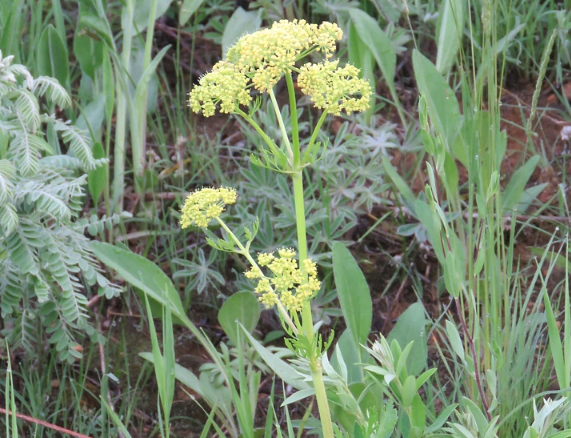Prairie Parsley

Prairie parsley (yellow center) with companion plants western sunflower, lead plant, silky aster, stiff goldenrod, round-headed bush clover, lupin and June grass. Image by Debra Noell.
Native plant communities are the foundation of ecological restoration. Land practitioners spend most of their time trying to re-establish native flora with the hope that native fauna will follow. Some native plant species re-establish quickly, whereas others take years and years of patience and faith. A few plant species, however, remain mysterious, escaping our best efforts to understand their secrets of survival. For me, prairie parsley is one of these enigmas.
I first discovered prairie parsley roughly 15 years ago while hunting wild parsnip, an invasive species. Like parsnip, prairie parsley has a thick stem and an umbellate (flat) yellow flower. However, its leaves are somewhat triangular and deeply lobed, radically different from parsnip leaves. Prairie parsley is typically a smaller stature plant and tends to bloom earlier then parsnip. Like parsnip, prairie parsley lives for a few years as a small plant (rosette) before bolting, flowering and dying.
I found three blooming plants that day, all in dry sandy prairie areas. Every year since, I’ve only found two or three blooming plants and a couple more rosettes. I’ve never witnessed a population boom from plants that appeared to produce good amounts of seed. Often, I’d find two blooming plants near each other, but in subsequent years, there would be none in that general area in spite of what appeared to be good seed production. Then, like magic, the plant would reappear in another location far away from where I’d seen it previously.
From my observations (limited to one property), prairie parsley is an introvert, shunning the company of its own kind. And, in spite of its seed being rather large, it has the ability to travel a fair distance. The plant seems to prefer dry remnant prairie areas, but I’ve also seen it pop up occasionally in mature dry planted prairies. I do wonder how long it will persist at this isolated site. I have looked extensively for this plant at other properties, but so far have found none.
Curious as to what other natural resource managers had to say about prairie parsley, I did a little online research. Below is what I found:
According to the WI-DNR, prairie parsley is a State Threatened species found in prairies and open areas that were once savanna. It has a significant association with dry prairie and a moderate association with other prairie and savanna communities. Fire is thought to be important for its survival.
Per the MN-DNR, prairie parsley is considered a Special Concern species. Everything known about it is based on two herbarium specimens collected in 1892 and 1915. Recent botanical surveys have failed to locate this species, and it’s likely extirpated from the state.
The MI-DNR lists prairie parsley as Threatened – if it were to be rediscovered. It’s presumed extirpated with the last recorded observation in 1837.
According to Illinois Wildflowers, an online resource guide, prairie parsley is scattered across Illinois and appears to be declining. It’s an indicator plant of original prairie and rarely found in disturbed areas. This conservative species may require occasional fire to prosper.
Based on the above references, the future for prairie parsley doesn’t appear promising. Perhaps this plant has always been uncommon on the prairie landscape, popping up here and there as favorable conditions occurred. Given we have just a tiny fraction of our prairie landscape left, it’s likely that this species will soon only be found in historical records.
To those of you out there who manage natural lands home to the prairie parsley, godspeed; you’re its last hope.
Originally published in Environmental Returns.


